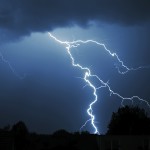Georgia Lightning Awareness Week is June 21-27, 2009
 Friday, May 8, 2009 at 08:48AM
Friday, May 8, 2009 at 08:48AM  Lightning is a deadly "by-product" of thunderstorms which are very common in Georgia, particularly in the spring and summer. Lightning kills an average of 100 people a year throughout the United States. Statistics show that on the average, lightning kills more people in the United States every year than tornadoes, floods, or hurricanes. It occurs mostly during the warmer months of June through September.
Lightning is a deadly "by-product" of thunderstorms which are very common in Georgia, particularly in the spring and summer. Lightning kills an average of 100 people a year throughout the United States. Statistics show that on the average, lightning kills more people in the United States every year than tornadoes, floods, or hurricanes. It occurs mostly during the warmer months of June through September.
To help Georgians prepare for lightning and other types of severe weather, GEMA's Ready Georgia - a statewide emergency preparedness campaign - offers the necessary tools that residents need to make an emergency supply kit, develop a communications plan and stay informed about potential threats. Ready Georgia's interactive Web site, www.ready.ga.gov, provides detailed information on Georgia-specific emergency preparedness and allows users to create a personal profile and receive a customized checklist and a family communications plan.
How to Protect Your Home from Lightning
Protect Electronics from Severe Weather
If lightning hits your house or nearby power lines, it can follow the wiring or phone lines into your home — ruining computers, TVs, stereos and other electronics. Your homeowner’s insurance may or may not cover damage from lightning. But one safeguard against electronics being “fried” by lightning is simply to unplug them whenever you’re expecting rain or a storm. Disconnect Internet, antenna and satellite-dish connections, even if your TV antenna is grounded (connected to the Earth by metal wires or cables so electricity has a quick path to the soil).
Surge protectors help protect equipment from power spikes (and distant lightning strikes that hit the electrical grid). But nearby lightning is so powerful it can jump through surge protectors. It’s been known to jump across an entire room (called side-flashing). When this happens, anything — or anyone — in its path could be in danger.
Reduce the Risk of Fire
You might want to consider protecting an entire building. Lightning rods protect a building from catching fire, not from electrical surges. They don’t increase or decrease the chance of lightning striking your house; they just provide a path for the electricity to reach the ground more safely. The rods at the top of the building are only the first part of a good system. Lightning hits the rods (instead of the building itself) because they’re higher than other points on the building. But when lightning strikes, the electricity needs to move to the ground. Cables conduct electricity from the lightning rods to the ground stakes (buried metal rods), and each connection must be secure so lightning doesn’t jump to the building. Lightning rods are not 100 percent effective in eliminating fires from lightning, but they reduce the likelihood of a lightning strike igniting the building.


Reader Comments